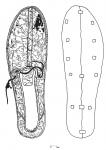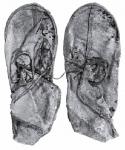08-09-2019, 08:54 AM
(This post was last modified: 08-24-2019, 07:57 AM by Crispianus.)
So moving on, André J. Veldmeijer, mentions in his article on the Luxor toggle boots another pair of shoes from the Pyramid of Pepy I, initially the dating was roman but there seems to be no basis in fact as all the features ascribed to as Roman also occur earlier.
There is some suggestion in "Une occupante inattendue de la pyramide du roi Pépy Ier" that these are turnshoes as well though its not clear (at least to me ) and the original author should have been able to tell this if so, as there are large pieces missing from the upper making it possible to see inside the shoe and see the seams.
As the pictures are not good enough (there are no construction drawings) to determine either way, my personal view is that this is a turn shoe with a new sole added, the method of which has largely hidden the external clues to its construction, and that the final sole was first laced in place and then the edge whip stitched to the original sole/upper seam region possibly to a rand.
An attempted translation of the french using an online translator, I've adjusted this in some cases to make the meaning clearer using the shoes themselves as a basis, though its by no means perfect, some parts have been omitted:
* My Comments
"Next to the purse was a pair of red leather adult soft shoes.
Both feet have a length of 23 cm and a width of 9 cm, a size of 34 points of Paris.
Apart from a few leather fragments missing on the top of the shoes, the pair is complete.
No deformation was detected; usage wear seems to be zero.
The sole is made of two layers of leather joined by a link (*seam?) which seems the usual technique in Roman times.
(* it depends on what the actual meaning is two layers or two pieces)
The top of the shoe consists of a main piece of red leather.
Along the mid-axis of the upper (*vamp), a piece of leather, 7 mm wide, purple color, reinforces the top of the shoe (18). It is fixed by two seams(* what looks like straight stitch ?).
The top of the shoe and the sole are joined by a stitched seam (*turnshoe? depends on which is being refered to it looks to me like there are two seams visible 19)
The opening is bordered by an upturned edge of red leather, stitched to the edge of the upper.
A red leather tongue has been attached.
At the level of the instep, another piece of leather forming the buttress, of violet color,
was secured by an overlock stitch (*a violet reinforcing patch has been added by whip stitching).
A quarter of 12 cm height encloses the ankle. On each side, two eyelets arranged one above the other were reinforced
by a stitched leather pad. They leave the passage for a lace of 29 cm of length.
One of the strands of the lace of the left shoe bears the mark of a repair(20). In fact, because it was too short, a leather lace of the same thickness was added to it.
Finally, three unreinforced eyelets allow to attach the shoe on the dorsal region of the foot.(*? not visible or at least I cant see them)
18 This type of sewing has been found in
leather traces updated to Mons Claudianus,
S. WINTERBOTTOM, BIFAO 90, 1990, p. 79, FIG. 7, No. 7,
No. 9-10.
19 According to Philippe Atienza, the regularity of the sewing shows that
the shoe has been sewn upside down using a two or three strand braided
linen thread.
(*? perhaps inside out is meant here or literally the shoe was held
upside down whilst the final sole was stitched on, though I think this is wrong)
20 The end of the lace in place received an incision in its length. It was the same
for one end of the thong that we wanted to add.
He just had to pass each of the incision-free ends into one of the incisions.
Pulling on the free end allowed to get a lace of the right size.
This addition is the very act of a professional; the demonstration was made to me in
the workshop of the cobbler-masters of Hermès.
(*this is basic knowledge for anyone wanting to lengthen a lace so not necesarily a sign of a professional)
In the twentieth dynasty, there seems to be a model called "high leather shoes".
Such a pair intended especially for women and children could be bought for two deben.
(*Paragraph ommited)
However the date of the third-fourth century (*AD ) can be proposed, because the assembly of the sole to the upper of the shoe is quite particular. In addition, tabs, quarters, laces and buttresses at the instep appear to be late-dated."




Feel free to comment...
There is some suggestion in "Une occupante inattendue de la pyramide du roi Pépy Ier" that these are turnshoes as well though its not clear (at least to me ) and the original author should have been able to tell this if so, as there are large pieces missing from the upper making it possible to see inside the shoe and see the seams.
As the pictures are not good enough (there are no construction drawings) to determine either way, my personal view is that this is a turn shoe with a new sole added, the method of which has largely hidden the external clues to its construction, and that the final sole was first laced in place and then the edge whip stitched to the original sole/upper seam region possibly to a rand.
An attempted translation of the french using an online translator, I've adjusted this in some cases to make the meaning clearer using the shoes themselves as a basis, though its by no means perfect, some parts have been omitted:
* My Comments
"Next to the purse was a pair of red leather adult soft shoes.
Both feet have a length of 23 cm and a width of 9 cm, a size of 34 points of Paris.
Apart from a few leather fragments missing on the top of the shoes, the pair is complete.
No deformation was detected; usage wear seems to be zero.
The sole is made of two layers of leather joined by a link (*seam?) which seems the usual technique in Roman times.
(* it depends on what the actual meaning is two layers or two pieces)
The top of the shoe consists of a main piece of red leather.
Along the mid-axis of the upper (*vamp), a piece of leather, 7 mm wide, purple color, reinforces the top of the shoe (18). It is fixed by two seams(* what looks like straight stitch ?).
The top of the shoe and the sole are joined by a stitched seam (*turnshoe? depends on which is being refered to it looks to me like there are two seams visible 19)
The opening is bordered by an upturned edge of red leather, stitched to the edge of the upper.
A red leather tongue has been attached.
At the level of the instep, another piece of leather forming the buttress, of violet color,
was secured by an overlock stitch (*a violet reinforcing patch has been added by whip stitching).
A quarter of 12 cm height encloses the ankle. On each side, two eyelets arranged one above the other were reinforced
by a stitched leather pad. They leave the passage for a lace of 29 cm of length.
One of the strands of the lace of the left shoe bears the mark of a repair(20). In fact, because it was too short, a leather lace of the same thickness was added to it.
Finally, three unreinforced eyelets allow to attach the shoe on the dorsal region of the foot.(*? not visible or at least I cant see them)
18 This type of sewing has been found in
leather traces updated to Mons Claudianus,
S. WINTERBOTTOM, BIFAO 90, 1990, p. 79, FIG. 7, No. 7,
No. 9-10.
19 According to Philippe Atienza, the regularity of the sewing shows that
the shoe has been sewn upside down using a two or three strand braided
linen thread.
(*? perhaps inside out is meant here or literally the shoe was held
upside down whilst the final sole was stitched on, though I think this is wrong)
20 The end of the lace in place received an incision in its length. It was the same
for one end of the thong that we wanted to add.
He just had to pass each of the incision-free ends into one of the incisions.
Pulling on the free end allowed to get a lace of the right size.
This addition is the very act of a professional; the demonstration was made to me in
the workshop of the cobbler-masters of Hermès.
(*this is basic knowledge for anyone wanting to lengthen a lace so not necesarily a sign of a professional)
In the twentieth dynasty, there seems to be a model called "high leather shoes".
Such a pair intended especially for women and children could be bought for two deben.
(*Paragraph ommited)
However the date of the third-fourth century (*AD ) can be proposed, because the assembly of the sole to the upper of the shoe is quite particular. In addition, tabs, quarters, laces and buttresses at the instep appear to be late-dated."
Feel free to comment...
Ivor
"And the four bare walls stand on the seashore. a wreck a skeleton a monument of that instability and vicissitude to which all things human are subject. Not a dwelling within sight, and the farm labourer, and curious traveller, are the only persons that ever visit the scene where once so many thousands were congregated." T.Lewin 1867
"And the four bare walls stand on the seashore. a wreck a skeleton a monument of that instability and vicissitude to which all things human are subject. Not a dwelling within sight, and the farm labourer, and curious traveller, are the only persons that ever visit the scene where once so many thousands were congregated." T.Lewin 1867






